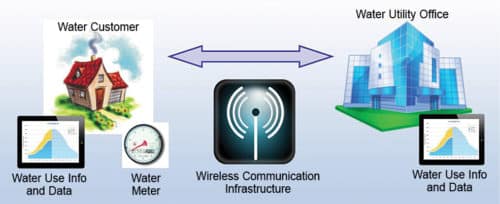Water-related data includes quality, pressure, level, dissolved oxygen and more. Data management is essential to keep track of this large amount of sensor and meter data collected in real time

Water scarcity is caused mainly by non-revenue water, which is the water lost before it is available for consumption. Physical loss due to leakage from such reasons as corrosion and material degradation remain the worst offenders. Others include theft through water tapping, supply for putting out fires, etc.
For dealing with failure of pipelines, direct methods include techniques like cutting a section in the pipe. These are expensive and require manual labour. Although, indirect ones involving sensors and radar do not require exposing the pipe, these are still costly and short-ranged.
The long-term solution to consuming water sustainably is smart water management. A smart water grid system covers everything ranging from storage to consumption. Smart water solutions incorporate both hardware and software, such as smart water meters, wireless sensors (for communication) and analytics, for optimisation of the water cycle.
Real-time intelligent monitoring at the operators’ end aids in mitigating possible risks like contamination of water. At the consumers’ end, real-time feedback enables cost-cutting and water conservation. In this article, we focus on smart water meters.
According to a report by ResearchandMarkets.com, the global smart meters market was at US$ 8.6 billion in 2018 and is projected to grow at a CAGR of over seven per cent to reach US$ 12 billion by 2024 owing to the growth of smart cities.
It can be observed that meter readings taken manually are often inaccurate. Also, in harsh weather conditions, measurements cannot be done and so estimations have to be made. Bills are generated from these readings, which are usually obtained once or twice a month.
Smart meters, on the other hand, record water consumption at a frequent pace and provide information reports daily for both customers and utilities. Automatic billing is generated based on usage, doing away with the practice of the same billing for every apartment. These provide security from tampering attempts and accuracy better than manual meters.
For monitoring at remote locations, wireless communication is used to establish a connection with local area network (LAN) or wide area network (WAN). Meters can be powered by batteries, and have a life span of about twenty years.
Automatic meter reading systems ensure transparency at customers’ end. Customers know about their consumption continuously and are notified of any irregularity that might occur due to problems in the systems. Automatic meter reading is gradually getting replaced by advanced metering infrastructure since data is accessible in real time. Unlike automatic meter reading, advanced metering infrastructure transmits data bidirectionally, to and from the customer and the supply chain.
Water-related data includes quality, pressure, level, dissolved oxygen and more. Data management is essential to keep track of this large amount of sensor and meter data collected in real-time. It can then be easily made available to the water board authority, engineers and consumers through bills, or on the Internet via Web portals and apps. Analytics aids in extracting useful information and improving efficiency.
Along with the residential sector, smart meter deployment is rising in commercial and industrial sectors also. Key players such as Itron, Xylem and Maven Systems are expanding their presence by entering new markets.
For further adoption of smart meters, several challenges need to be considered. No other person knows the schedule of the consumer as meters do not check which appliance is being used at a particular time. Also, while taking readings from a remote location, radiations of low energy levels are emitted and are, hence, less harmful.
Despite this, security and radio-waves emissions are seen as potential risks when it comes to smart meters.
Initial investment and operating costs are high. Proper technical standards and regulations should be established to ensure smooth deployment. Once existing meters become obsolete, jobs must be redesigned to cater to the new necessities.









